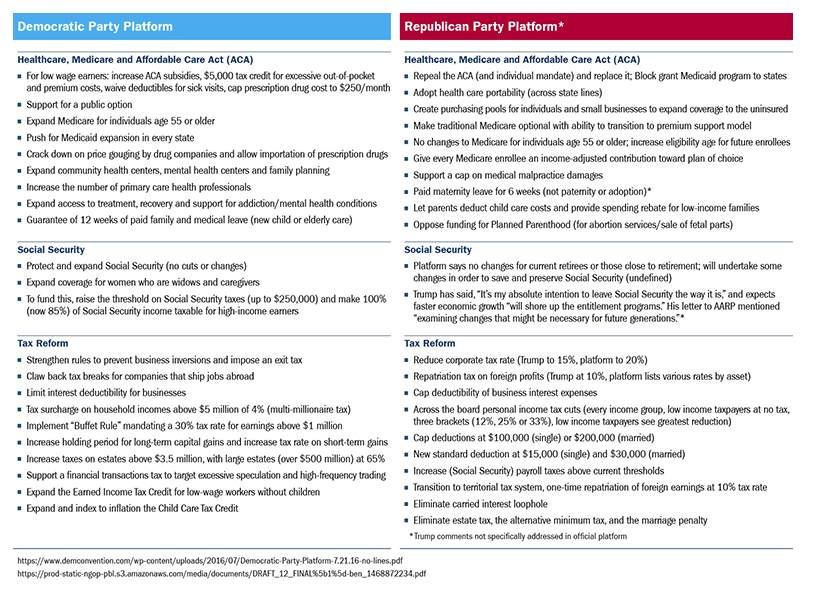The uncertainty of this election makes it hard to predict the long-term outcome of either a Clinton or Trump administration. For clues, focus on where the two candidates stand on three key issues.
In politics, the only certainty is uncertainty. This is particularly true in the 2016 presidential election. Donald Trump’s economic proposals have been relatively limited in focus, although he says he supports the Republican Party’s platform in principle. Secretary Hillary Clinton has provided more details of her economic proposals, which are largely in line with the current administration. So the post-election environment is likely to be more uncertain and harder to assess with a Trump victory than a Clinton win. That said, there’s still opportunity to lift the cloud of uncertainty and inform views ahead of Election Day on November 8.
Wide differences over three key issues
With so many issues we can talk about, let’s narrow our focus to three that really matter to financial advisors and their clients:
- Healthcare, Medicare and the Affordable Care Act (ACA)
- Social Security
- Tax reform
Our analysis relies on official party platforms, candidate websites and more recent speeches from both candidates as they fine-tune their messages. Generally, the Trump agenda is geared to comprehensive reforms in a broad fashion while Clinton is targeting key policy issues for change. The table below summarizes where the two candidates stand on the three issues. This is not meant to be an all-inclusive list, just a brief of some of the major proposals.

Democrats adopt a more progressive platform
The Democratic platform has moved to more progressive positions than it's been under President Obama. This is likely due to the influence of Sen. Bernie Sanders’ campaign and the need for party unity. The platform focuses on supports for workers and the middle class, with a more activist and expanded role for federal government. Clinton’s plan aims to defend the current Social Security program, opposing any effort to privatize it, cut benefits or lengthen age requirements. Clinton would also expand benefits to widows and caregivers at home. Clinton tackles those increased costs by increasing Social Security taxes via a higher threshold of $250,000 of earnings. She wants to expand Medicare coverage to allow individuals over 55 to buy into Medicare and she favors increased subsidies to the ACA, where structural problems threaten its sustainability. Also, Clinton’s tax policies for individuals would largely extend those of the current regime except for the top 1% of income earners whose tax rates would rise materially.
Tax cuts are central to Republican platform
The Republican platform focuses more on growth and economic incentives, relief for businesses, tax reform, and a less activist government and regulatory policy. The main goal of the GOP platform is to reduce corporate and individual tax rates. Trump has repeatedly said he won’t cut Social Security. But he has also said he plans to stabilize the program through faster growth and job creation that will generate more payroll taxes. Keep in mind that some of his advisors have mentioned efforts to review Social Security and Medicare in a bipartisan way after the election. So there are some differences that will need to be reconciled. Trump and the Republicans both agree that the ACA needs to be repealed or overhauled. Trump has also proposed simplifying the tax code and implementing tax cuts for all brackets. If implemented, there would be an enormous drop in government revenues. The hope is that faster growth kicks in quickly to prevent debt costs from escalating rapidly.
Reality check on the candidates’ proposals
The Long-Term Budget Outlook of the Congressional Budget Office (CBO) provides little hope that any program can be expanded without large increases in taxes and/or debt. Budget deficits are already running north of 3% and set to rise in coming years to pay for current entitlement programs. Social Security, Medicare and Medicaid, and ACA expenditures already account for half of all spending. These mandatory programs will eat up a growing share of revenues and encroach on discretionary spending and limit any fiscal stimulus planned in the future that has garnered support from both candidates.








